| URLs in this document have been updated. Links enclosed in {curly brackets} have been changed. If a replacement link was located, the new URL was added and the link is active; if a new site could not be identified, the broken link was removed. |
Government Policy Resources for Science and Technology Topics: A Case Study
Janette Prescod
Government Documents Coordinator
jprescod@utk.edu
Sandra Leach
Associate Dean for Collections
sandra-leach@utk.edu
Thura Mack
Coordinator, Community Learning Services
tmack@utk.edu
University of Tennessee, Knoxville
Knoxville, Tennessee
Abstract
Research librarians should be literate in locating government resources at both federal and state levels. Although assistance with policy research may not be as frequently requested as other subjects, librarians need to be knowledgeable in this subject area. Policy resources produced by federal and state legislative and executive agencies can be challenging to locate and interpret. This article examines congressional and other governmental sources of policy information using an environmental catastrophe, the Tennessee Valley Authority (TVA) Coal Ash Spill in Kingston, Tennessee, as a case study to illustrate an approach to researching environmental policy information. Information on the Coal Ash Spill is an example of a request that might be received at any research assistance desk employing a cadre of librarians with specialization in various disciplines, including science and technology.
Introduction
Librarian roles continue to change and adjust as merged services and new patterns of providing research assistance develop. All reference librarians, regardless of specialization, should be equipped with the minimum basic skills necessary to handle inquiries in areas of knowledge outside of assigned responsibilities. Having the background knowledge and understanding of public policy issues at the national, state, and local levels helps reference staff provide better quality government information assistance to users.
Scientific research is interdisciplinary and collaborative and scientists are often called upon to help resolve issues of national interest, such as environmental disasters. Scientific data are critical for developing impact assessment studies that are often used to advocate for new laws. Knowing where to look for policy information and what research tools to use is pivotal to guiding the user in the identification of key resources. The TVA Coal Ash Spill disaster serves as a practical context for this study, from its initial occurrence through examination of the responses of many agencies, including the development and implementation of policy proposals.This approach moves beyond the traditional book and journal literature to primary and secondary government documents produced at the national, state, and local levels. Although this method requires more comprehensive information gathering and critical review of source materials, it mines pertinent resources that often remain undiscovered during the customary research process.
Case Study -- The Tennessee Valley Authority (TVA) Coal Ash Spill
The TVA Coal Ash Spill is an excellent example for illustrating access to primary source government information available to the public following an environmental disaster. It occurred on Monday, December 22, 2008 at the TVA Kingston Fossil Plant in Kingston, Tennessee, and is ranked as one of the largest coal ash spills in the United States. A retaining wall failed, releasing approximately 5.4 million cubic feet of coal ash into the Clinch and Emory rivers and on to the surrounding ground surface areas (Tennessee Department of Environment and Conservation 2008). The ash sludge, containing arsenic, selenium, and mercury (TVA 2009) could have deleterious effects on the water, land, and air as well as on people. Families in the community were uprooted with little notice and evacuated from ruined properties.
Framework and Research Tools
It is inevitable that at various points in time, researchers will be looking at many aspects of the spill, ranging from the environmental risks presented by the coal ash waste to assessment of the effectiveness of governmental response and action. The natural first step is to find the details of when, where, how, and why the spill occurred by reviewing local newspaper articles and Internet resources. Once the basic facts are determined, the researcher can identify content produced by agencies at the local, state, and federal levels.
This paper traces the path of discovery of government documents by examining the roles, responsibilities and actions of governmental agencies involved in disaster cleanup and problem resolution. The first step is to begin with the agency that has ownership and responsibility for the geographical location. In this case study, the TVA was the responsible agency.
Tennessee Valley Authority's Response
The TVA is an independent federal agency that functions as a federal corporation. Established in 1933, it is the nation's largest public power company with responsibility for regional power development in the Tennessee Valley area. TVA supplies electricity produced from fossil fuel, nuclear and hydropower plants, as well as some renewable sources. TVA estimates that cleanup costs for the Kingston Coal Ash Spill could range between $525 and $825 million (U.S. Environmental Protection Agency 2009). Some sample publications on the topic are listed below. The best strategy for access to fact sheets, documents, and reports from the TVA is on the web site entitled "Kingston Recovery" at: http://www.tva.gov/kingston/.

Response from State of Tennessee Agencies
State and local government agencies play a significant role in natural disasters that occur in communities within the state even when there is an overarching federal responsibility. The Kingston Coal Ash spill demonstrates that Tennessee state and local agencies fully participated by working closely with the TVA and federal authorities to help with the emergency response to contain the spill. Two key Tennessee government agencies worked in collaboration with the TVA and the Environmental Protection Agency (EPA) to review and institute cleanup operations for the spill. The Tennessee Department of Environment and Conservation (TDEC) and the Tennessee Department of Health (TDH) provided immediate assistance to citizens, residents, businesses, and local government administrations. State agencies continue to support services and resources, and to monitor compliance with state laws and regulations.
The role of the Tennessee Department of Health was to test and observe the health conditions of the residents in the areas. Public health officials deployed public health staff to obtain feedback from residents near the spill regarding their contact with the spill debris. TDH officials opened a hotline and other outreach services for the residents of Kingston communities to relay health-related concerns. Agency Internet sites are excellent avenues to quickly and easily capture documents that pertain to the TVA Spill. Press releases and fact sheets provide regular updates and general information for the community.
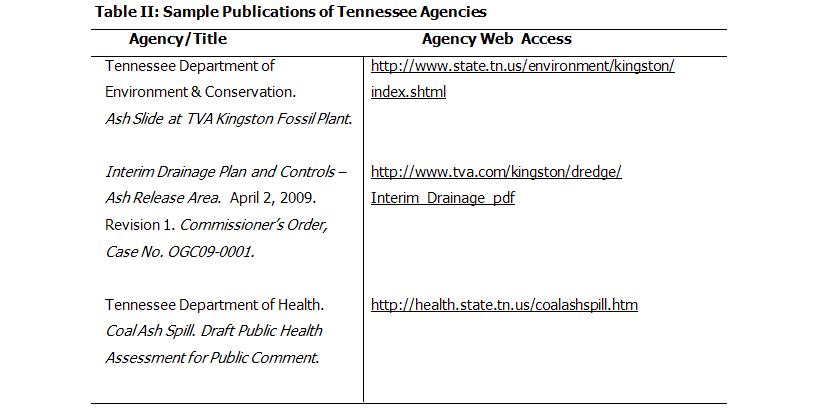
State of Tennessee Laws
The Environmental Protection Agency surveyed water and land contamination caused by the spill and assisted in the cleanup by monitoring TVA response operations. The Tennessee agencies TDEC and TDH worked with the EPA to determine the risks to local residents presented by the ash released from the Kingston Industrial Landfill. TDEC monitored the municipal drinking water daily. On June 4, 2009, the agency used its regulatory authority to levy a fine of $11.5 million in penalties against TVA for violations of the state's Water Quality Control Act and Solid Waste Disposal Act (Tennessee Department of Environment and Conservation 2009). Environmental legislation enacted by the state of Tennessee contains similar provisions to those found at the federal level. However, state statute requirements may be significantly more restrictive than federal law.
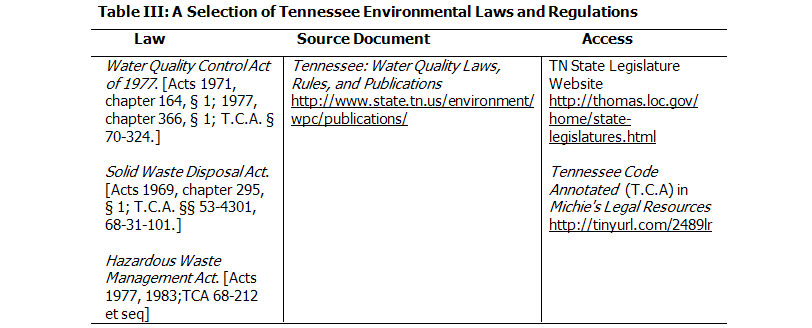
Environmental Protection Agency (EPA)
The EPA is the federal agency responsible for safeguarding Americans against environmental pollutants on land, air, and waterways. When a disaster occurs that threatens human health and the environment, such as the Kingston Coal Ash Spill, EPA staff test the environmental effects by sampling the pollutants in the surrounding land and water. Findings establish whether existing federal environmental laws have been violated. The results determine the directives for EPA's work with state and local emergency management agencies. The agency oversees operations for restoration and cleanup of the disaster areas and investigates whether the enforcement of regulatory policies that require public compliance need to be strengthened. EPA established the Kingston Coal Ash Spill "to be an unpermitted discharge of a pollutant under the Clean Water Act" (U.S. EPA 2008). EPA continues its work with state and local agencies to reduce health hazards and other risks by regulating and enforcing federal laws that protect against pollutants.
The TVA Coal Ash Spill disaster is an example of how pragmatic approaches are applied to find policy solutions to community problems. Although the ash and coal waste dumped at the site are hazardous to public health and the environment, existing federal regulations were not violated. A coalition of community activists and residents began pushing for legislative changes to the Clean Water Act that would label coal ash as hazardous waste and ensure stricter and safer priority handling of these materials. Differences of opinion aired at community hearings alerted residents to the gravity of the situation and the need for policy changes to help minimize the environmental damages of future disasters. EPA was criticized for not scheduling a public hearing in or near Roane County, Tennessee, the site of the coal ash spill. At the hearing held in Knoxville, Tennessee on October 27, 2010, in response to comments, EPA announced proposals for new standards to regulate coal ash as a hazardous waste (U.S. EPA 2010). In June 2011 these regulations have not yet been finalized. The table below lists laws and regulations most relevant to the TVA Spill.
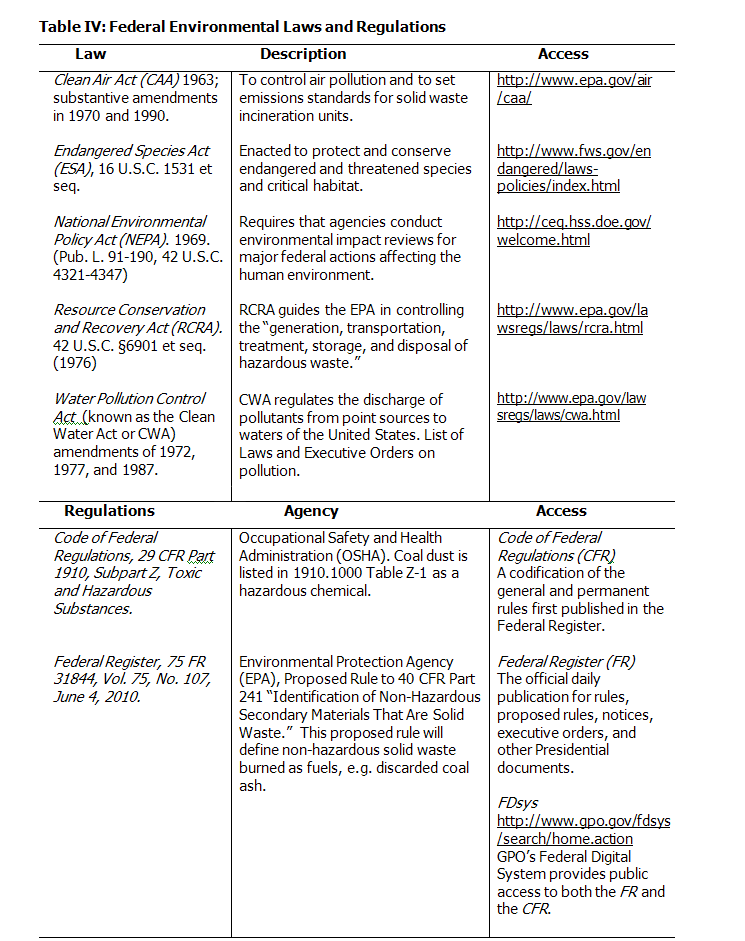
The best access to EPA publications is via the portals on the EPA Web site at http://epa.gov/ which provides access to free digital and print publications. A few are listed below, with two possible sources for such publications in the "Access" column.
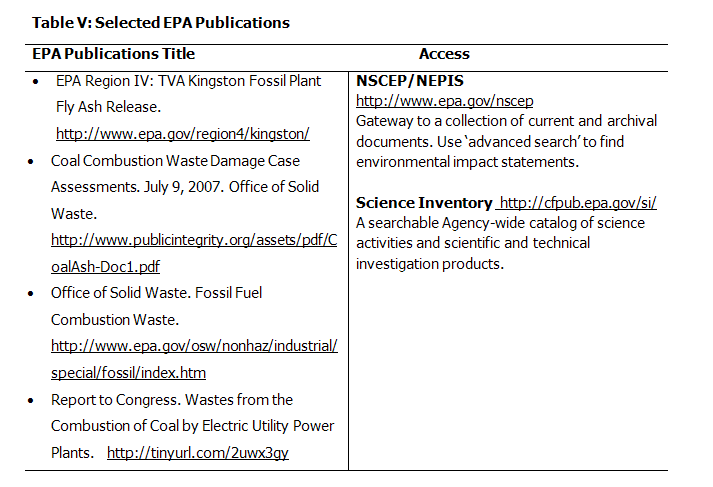
Understanding the Public Policy Process
In order to gain a better understanding of the public policy process, librarians need to know how policies originate, develop, and are implemented. Congress, its staff, and other information specialists work behind the scenes to gather, organize, and catalog an enormous volume of information intended for use by elected officials in the national legislature of the United States. When policy issues are successfully navigated through the legislative process, hearings, reports, and documents produced from Congressional Committee deliberations are available to the public. These materials are critical for policy analysts' and researchers' use to determine the intent of Congress during the decision-making process that resulted in the passage of a piece of legislation. Public policy issues are complex and often contentious. It is difficult to determine fact from fiction when conjecture and innuendo on hotly debated issues are spread rapidly on the Internet. Examination of the documents and information used by Congress is the key to tracing the path of legislation from the initial idea stage to final passage.
How well and how quickly Congress responds to problems in local communities depends on the magnitude of the problem and the volume of media exposure. Controversial issues are more likely to make it to the House and Senate calendars because of their effect on the voting public. The safety and environmental problems created by the TVA Coal Ash Spill received national attention, and Congress reacted quickly with investigative hearings. But congressional decision-making achieved through committee consideration and deliberation is often slow and cumbersome. Whether an issue receives immediate attention also depends on how it fits the agendas of the two political parties. A careful review of congressional documents will reveal the supporting and opposing sides of the case for reform, the arguments presented, and the solutions recommended. In particular, finding the views of district representatives and senators on the problem is an important element in community advocacy.
U.S. Congress Information Providers
Scientific studies and other science information avenues are all potential sources of information for the Congress. Information has to be thoroughly sifted, evaluated and judged on its merits before it can be used to support proposals for amending or creating legislative policies. While there are a growing number of science-related policy issues on the congressional agenda, very few members elected to Congress are scientists, or even have science-related backgrounds (Kady & Jalonick 2004). Committee members, as well as the general public, often find it difficult to separate fact from fiction. As a matter of practice, members of Congress rely heavily on their staffs to find information pertinent to a particular issue.
Both government and non-government providers supply information to Congress. Congress naturally seeks information first from its own research investigative agencies. There are three congressional agencies that contribute vital, comprehensive analyses to help inform important policy decisions that are under consideration by Congress. The Congressional Research Service (CRS), the Congressional Budget Office (CBO), and the Government Accountability Office (GAO) have a mandate to provide information requested by Congress to help meet its constitutional responsibilities. Each agency has a special role in providing non-partisan, authoritative, and timely reports based on sound analysis to assist Congress in balancing the act in legislative debates. Congress has to find objectivity and common ground from advice provided by government agencies and other public entities. Examples of publications from the CRS, CBO, and GAO on the topic of coal-fired technologies are provided. This topic is critical for researchers gathering background information related to the coal ash spill. Each agency's publications provide information that complements rather than duplicates their services to Congress.
The Congressional Research Service (CRS) serves as a consulting service for the Congress. As the research arm of Congress, the agency is credited with producing unbiased, analytic and objective reports for congressional committees covering a wide spectrum of public policy issues. The CRS functions as a department within the Library of Congress and employs professional analysts who are scientists, attorneys, and specialists with expertise in many subject areas. The agency responds to a variety of congressional inquiries for information and technical assistance. These may include bill comparisons and summaries, background studies, investigative reports, and statistical or legal analyses. The documents are non-partisan, created to assist and inform members of Congress, not to persuade or influence them. CRS researchers seldom conduct surveys or field research but instead employ standard documents such as journals, books, newspaper articles, court cases, and government publications to substantiate their data. Reports are subject to a review process in order to prevent bias and to preserve balance. Researchers cite sources consulted in each document (Brudnick 2008).
CRS reports have traditionally been available at cost from information providers. Many CRS reports are available full-text on the Internet, for example, from the Federation of American Scientists' web site. Individual reports may be requested from members of Congress. Many academic libraries provide access to the reports on microfiche with accompanying print indexes, or digitally in databases such as ProQuest Congressional.
Below are two examples of CRS reports on coal-fired power pertinent to the TVA Coal Ash Spill. Reports discuss the history of legislation and provide a review of the current situation.
- Capturing CO2 from Coal-Fired Power Plants: Challenges for a Comprehensive Strategy. April 15, 2010.
- Managing Coal Combustion Waste: Issues with Disposal and Use. January 12, 2010.
The Congressional Budget Office (CBO) is often described as the budgetary arm of Congress. It produces forecasts of cost estimates and analyses of the budgetary effects of new proposals before the Congress. Many factors coalesce to influence spending including economics and population growth. CBO's budgetary and fiscal advice provides the guidance for Congressional committees to make informed decisions that keep spending under control. CBO provides free access to publications from 1975 to present on their home page. These are also accessible via the Catalog of U.S. Government Publications. An example is listed below.
- The Costs of Reducing Greenhouse-Gas Emissions. Economic and Budget Issue Brief. November 23, 2009.
The Government Accountability Office (GAO) serves as the investigative arm of Congress. It functions as an independent watchdog agency to keep congressional accountability in line with established laws, rules, and regulations. The GAO's policy analyses and opinions on government effectiveness drive new laws or amendments to existing laws aimed at improving current operations. GAO employs public policy analysts that work closely with other agencies in the executive branch to gather content for their investigations. Reports are requested by Congress to investigate solutions to problems with government funded programs. They serve to increase public awareness of national issues. Access to reports and testimonies from 1890 to current is provided on the GAO Web site. The Catalog of U.S. Government Publications also serves as a comprehensive index to GAO reports with links to the electronic text. An example of a report follows.
- Coal Combustion Residue: Status of EPA's Efforts to Regulate Disposal. GAO-10-85R, October 30, 2009.
A rich variety of reports produced by these three agencies can be used to illustrate science-related issues under scrutiny by congressional committees. This information is also pertinent and valuable for students and researchers studying policy issues in science and technology or social science subjects. The agencies address congressional issues but from different perspectives.
Congressional Committees
There are committees in the House of Representatives and in the Senate with oversight responsibility for science and technology issues. House and Senate standing and select committees are subject to change with each new Congress depending upon the political party in power. Recent committee hearings and reports are posted on their Web sites as they are released to the public. To find retrospective committee publications use the Catalog of U.S. Government Publications or other legislative databases such as ProQuest Congressional. Table VI lists sample committee hearings.
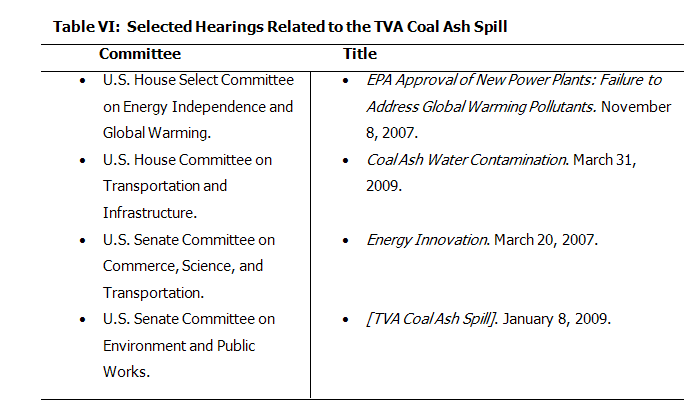
Other U.S. Federal Agencies
There are other U.S. government agencies that have stakeholders' interest or responsibility for monitoring or regulating environmental policy. Many respond to information requests from Congress. Such requests may include: testimony from agency officials, reports, technical documents, budget information, and answers to key questions about a particular issue that falls within their mission. The list below offers a representative sampling of agencies with science and technology responsibilities. Agency Internet sites are good starting points when looking for documents. Information on the TVA spill may eventually appear in some of these sources.
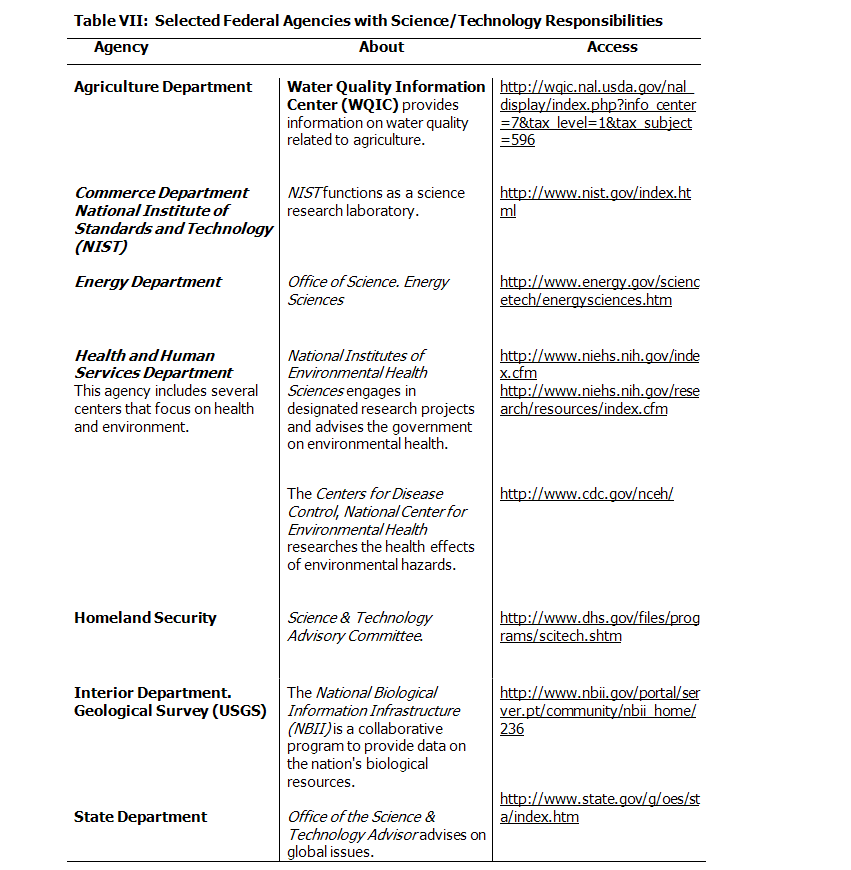
Science Information Providers to the President
The President and members of his Cabinet take notice when the level of public attention to policy issues escalates. Science and technology topics have been hotly debated in the public arena in recent years. Who advises the President on issues such as stem cell research, coal ash residue, and other science matters? Federal agencies are responsible for informing the President of science and technology policy issues with budgetary, economic, national security or foreign policy linkages. In addition, science advice comes from boards, commissions, and task forces convened by the President, formed at the executive agency level, or from outside groups and organizations. Task forces also play an important role in guiding the policy and technology initiatives of the Administration and the Congress. The report of the Task Force on Carbon Capture and Storage (CCS) concluded that CCS can play an important role in domestic greenhouse gas emission reductions while preserving the option of using coal and other abundant domestic fossil energy resources.
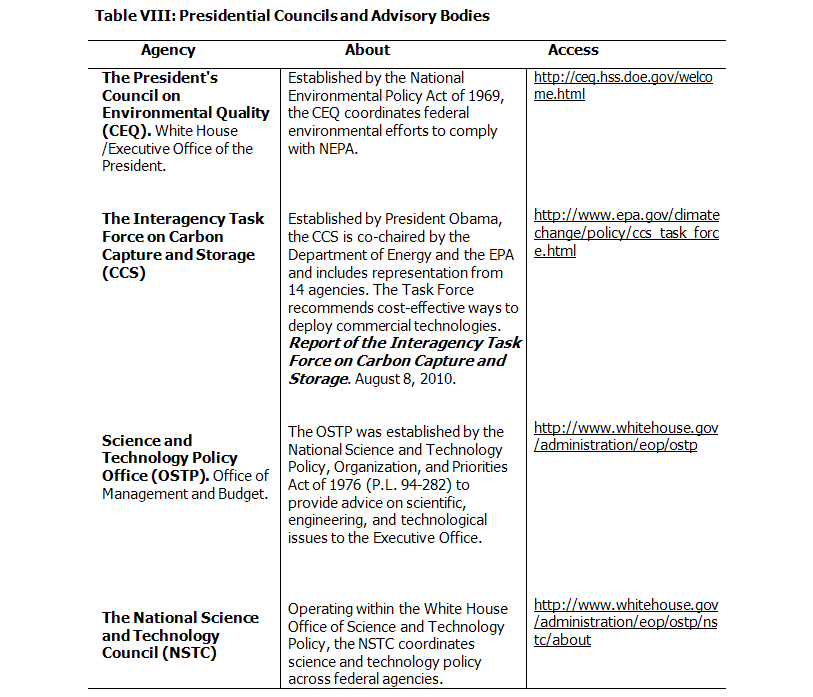
Selected Government Databases and Portals
- Agency for Toxic Substances & Disease Registry. Available from: http://www.atsdr.cdc.gov/
- Agricola. Available from: http://agricola.nal.usda.gov/
- Catalog of U.S. Government Publications. Available from: http://catalog.gpo.gov/F
- Congressional Budget Office. Available from: {http://www.cbo.gov/topics/}
- Congressional Research Service. Available from: http://www.loc.gov/crsinfo/
- Envirofacts. Available from: http://www.epa.gov/enviro/
- Environmental Impact Statement (EIS) Database. Available from: http://www.epa.gov/oecaerth/nepa/eisdata.html
- FirstGov.gov. Available from: http://www.firstgov.gov/
- Government Accountability Office. Available from: http://www.gao.gov/
- National Service Center for Environmental Publications (NSCEP). Available from: http://www.epa.gov/nscep/
- National Digital Library of Science (NSDL). Available from: http://nsdl.org/
- NTIS . Available from: {https://www.ntis.gov/products/ntisdb.aspx}
- PubMed. Available from: http://www.ncbi.nlm.nih.gov/pubmed
- Science.gov. Available from: http://www.science.gov/
Conclusion
The political process is of interest to all professions but librarians have a special responsibility in providing information about the concerns of the nation at large. Librarians with science and technology information discovery skills are involved in science policy issues that will provide opportunities to forge connections directly with the public. Public policy issues are cross-disciplinary and science-related issues are dominating the political landscape more than ever before. These provide librarians in all disciplines, including those specializing in science and technology, an opportunity to help facilitate information connections. Libraries can create help lines and information resources that will empower affected communities. Creating pathways to information literacy for a community's citizens and advocates provides quick access to documents and resources at the time of need. It may in some cases save lives.
References
Brudnick, I.A. 2008. The Congressional Research Service and the American legislative process. CRS Report for Congress, Order Code RL33471.
Kady, I.I.M. and Jalonick, M.C. 2004. Science, Policy Mix Uneasily In Legislative Laboratory. CQ Weekly 62 (27): 680-684.
Tennessee Department of Environment and Conservation. 2008. Ash Slide at the Kingston Fossil Plant. [Internet]. [cited 2011 June 17] Available from:http://www.state.tn.us/environment/kingston/
Tennessee Department of Environment and Conservation. 2009. Commissioner's Order, Case No. OGC09-0001 In the Matter of: Tennessee Valley Authority. [Internet]. [cited 2011 June 17] Available from: http://www.tn.gov/environment/kingston/pdf/orders/06_14_2010.pdf
Tennessee Valley Authority. 2009. Kingston Ash Incident: Evaluation of Potential Legacy Contamination in Local Sediments. [Internet]. [cited 2011 June 17] Available from: {http://www.tva.gov/kingston/pdf/KIF%20Legacy%20Sediment%20Summary-final%20_6_.pdf}
United States Environmental Protection Agency. 2008. Region 4: EPA's response to the TVA Kingston Fossil Plant Fly Ash release. Basic Information. [Internet]. [cited 2011 June 17] Available from: {https://archive.epa.gov/pesticides/region4/kingston/web/html/index.html}
United States Environmental Protection Agency. 2009. News Release: EPA announces new action to prevent coal ash releases. Washington, D.C. [Internet]. [cited 2011 June 17] Available from: http://yosemite.epa.gov/opa/admpress.nsf/d985312f6895893b852574ac005f1e40/b2856087389fb82485257574007409c1!OpenDocument&Highlight=2,enforcement
United States Environmental Protection Agency. 2010. Coal Combustion Residuals -- Proposed Rule. [Internet]. [Cited June 17, 2011] Available from: {https://web.archive.org/web/20100702233907/http://www.epa.gov/osw/nonhaz/industrial/special/fossil/ccr-rule/index.htm}
| Previous | Contents | Next |
